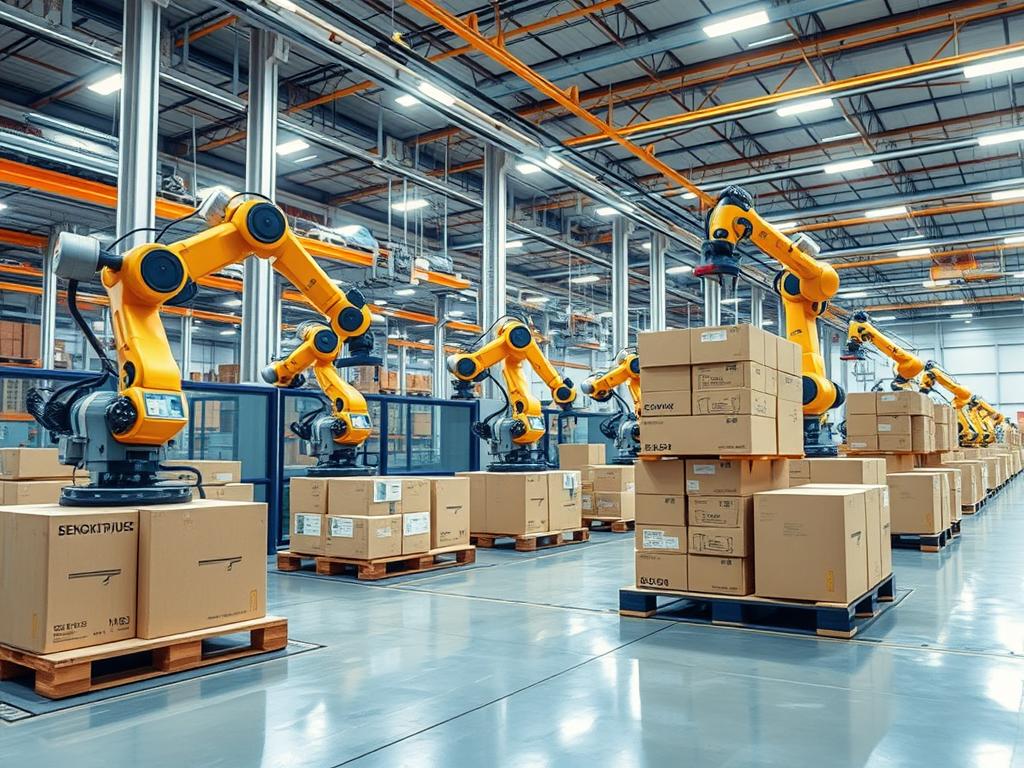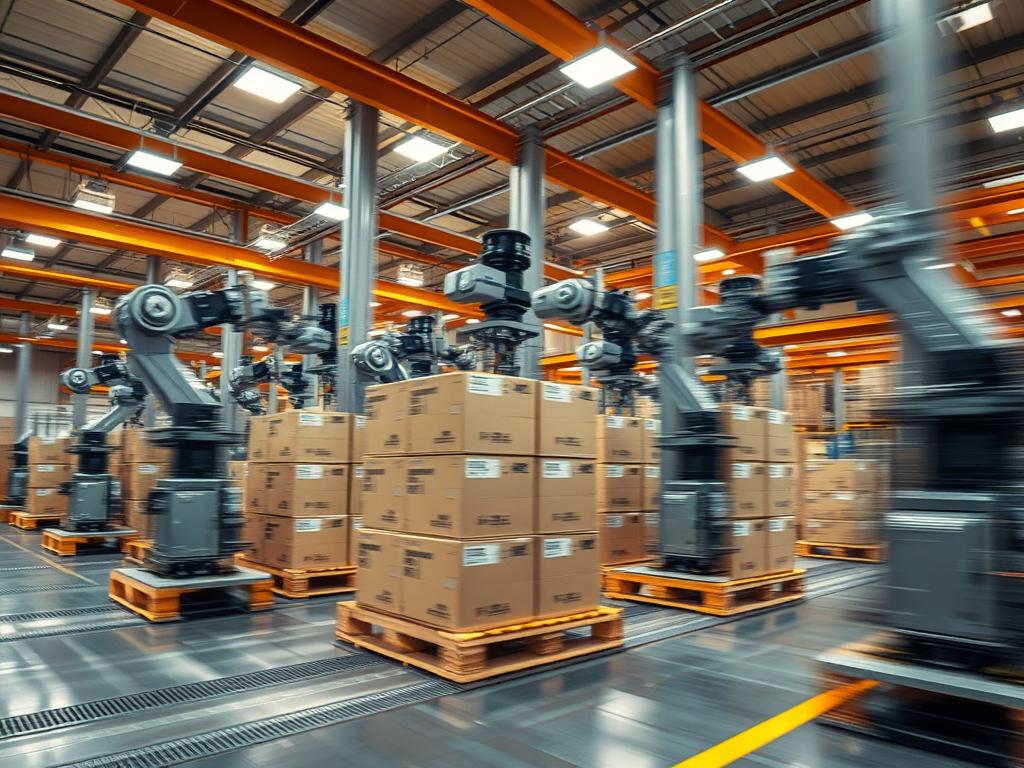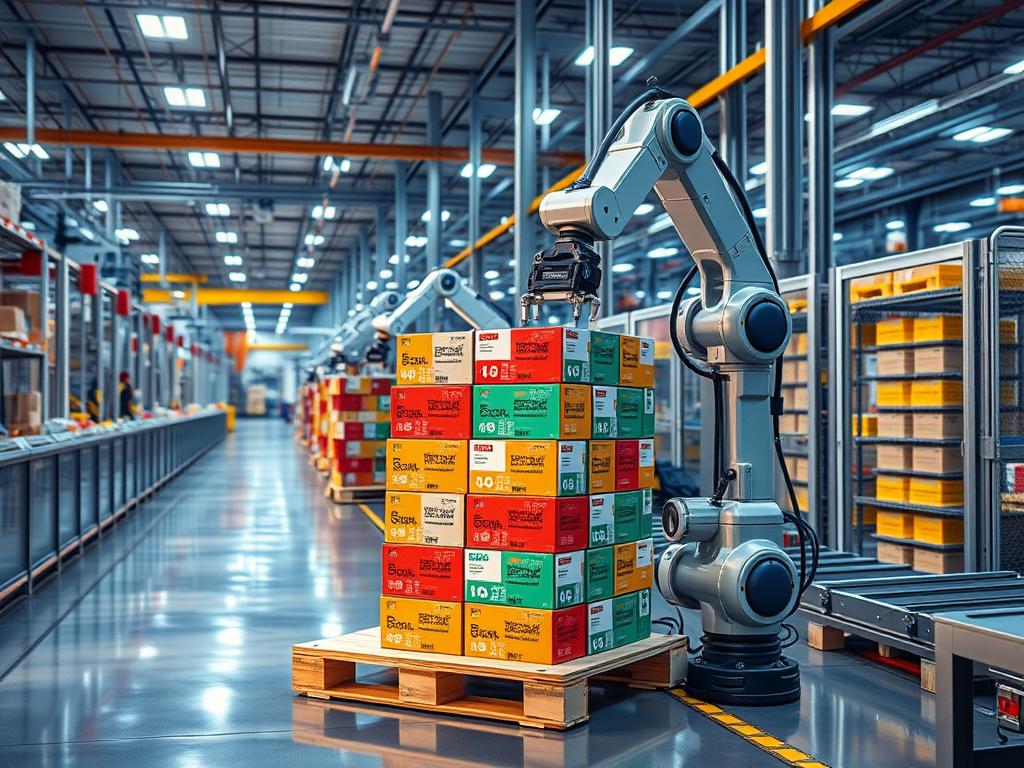By 2026, the global warehouse automation market could reach $30 billion. Robotic case palletizer systems are driving this growth. In manufacturing, there’s one robot for every 71 humans.
Manual palletizing often causes workplace injuries and product damage. Repetitive lifting and bending can lead to musculoskeletal problems. Human error may result in unstable pallets.
Robotic palletizing solutions offer a new approach to end-of-line packaging automation. These systems use robotic arms with sensors and grippers. They stack products on pallets with high precision and speed.
Various industries benefit from these advanced systems. Food and beverage, pharmaceuticals, and e-commerce see improved productivity. They also experience fewer workplace injuries and consistent pallet quality.
Robotic case palletizers are changing logistics and supply chain management. Let’s explore how these systems work and their real-world applications. We’ll see how they’re shaping the future of logistics.
What is a Robotic Case Palletizer?
Robotic case palletizers are advanced automation solutions that transform logistics and manufacturing. These industrial robotic palletizers appeared in the 1980s, improving palletizing technology. They cost less and offer more flexibility than mechanical versions.
Definition and Functionality
Case handling robots automate the stacking of products onto pallets. They use advanced robotic arms with multiple degrees of freedom. This allows for precise and efficient product handling.
Palletizing robots replace manual labor, boosting productivity and safety. They can handle up to 30 cases per minute, depending on the task.
Robotic palletizers can handle up to 30 cases per minute, depending on the application, showcasing their impressive speed and efficiency.
Key Components of Robotic Palletizers
Industrial robotic palletizers have several crucial parts that work together smoothly:
- Industrial robot arm
- End-of-arm tooling (EOAT)
- Pallet dispensers
- Conveyor systems
- Vision systems (optional)
These parts allow robotic palletizers to handle various product sizes and pallet setups. This provides flexibility for different manufacturing needs. The EOAT secures products, while vision systems improve adaptability.

| Feature | Robotic Palletizers | Conventional Palletizers |
|---|---|---|
| Versatility | High | Limited |
| Space Requirement | Compact | Larger footprint |
| Secondary Tasks | Can perform | Limited capability |
| Payload Capacity | 25 kg to 700 kg | Higher for heavy loads |
Palletizing robot technology keeps improving. Manufacturers like FANUC offer many robots with different payload capacities. These advances in case handling robots boost efficiency across industries.
From food and beverages to pharmaceuticals and e-commerce, robotic palletizers are making a big impact. They’re driving productivity and streamlining operations in various sectors.
Benefits of Robotic Case Palletizers in Logistics
Robotic case palletizers are changing how logistics works. They make warehouses run smoother and faster. These robots offer many perks for businesses aiming to improve their operations.
Efficiency and Speed Improvements
Flexible case palletizing systems boost productivity in logistics. The FANUC M-410iC/110 can do 2200 cycles per hour. It’s the fastest palletizer out there.
Another FANUC robot, the M-410iB, can do the work of four people. This shows how much more efficient these systems are. They offer remarkable efficiency gains in warehouse operations.
Cost Savings and Return on Investment
Automated mixed case palletizing can cut packing time in half. This helps warehouses meet market needs faster. These systems use pallet space better, fitting more products per pallet.
Businesses using this tech often spend less on labor and operations. They see a good return on investment. Higher productivity leads to increased profits.
Enhanced Safety and Accuracy
Robotic palletizers make workplaces safer. They remove the need for manual heavy lifting. This lowers the risk of worker injuries.
They also improve accuracy with precise, programmable stacking patterns. This ensures consistent pallet quality and stability. Better accuracy means less packaging waste and product damage.

Robotic case palletizers offer clear benefits in logistics. They boost efficiency, cut costs, and enhance safety. These systems are changing warehouse operations across many industries.
Industries Utilizing Robotic Case Palletizers
Robotic case palletizers have transformed many industries, boosting efficiency and streamlining operations. These robotic depalletizing solutions offer versatile applications across different sectors. They address common challenges like labor shortages and quality control issues.
Food and Beverage Sector
In food and beverage, case handling robots ensure hygienic product handling and efficient packaging. These systems can handle up to 1,900 palletizing cycles per hour. Robotic palletizers excel in managing cheese, dairy, and cold storage items.
Consumer Goods Manufacturing
Consumer goods makers benefit from robotic palletizers’ ability to handle diverse product sizes and packaging types. These systems manage closed-top cases, trays, bags, and pails with ease. Automatic functions like pallet feed and slip sheet placement streamline operations.

Pharmaceutical Applications
In pharmaceuticals, robotic palletizers provide precision and traceability for regulatory compliance. They offer vision and scanning capabilities, ensuring accurate product handling and labeling. This tech is crucial for maintaining sensitive medical products’ integrity throughout the supply chain.
Retail and E-commerce
Retail and e-commerce use robotic palletizing systems to manage high-volume order fulfillment. E-commerce is expected to reach $893 billion in 2022. These systems integrate with enterprise systems, enabling efficient product tracking and distribution.
| Industry | Key Benefits | Typical Applications |
|---|---|---|
| Food and Beverage | Hygienic handling, high-speed operations | Dairy products, cold storage items |
| Consumer Goods | Versatile packaging handling, injury reduction | Cases, trays, bags, pails |
| Pharmaceuticals | Precision, traceability, regulatory compliance | Medical products, sensitive items |
| Retail and E-commerce | High-volume fulfillment, system integration | Order processing, distribution |
Key Considerations When Implementing Robotic Case Palletizers
Careful planning is crucial for implementing industrial robotic palletizers. Businesses must evaluate key factors to ensure successful integration. This approach maximizes efficiency and safety in warehouse operations.
Assessing Your Warehouse Layout
Evaluating your warehouse layout is the first step. Robotic systems are more compact than conventional palletizers. This makes them perfect for facilities with limited space.
A thorough assessment helps determine the best placement for your new system. It ensures optimal use of available space and smooth workflow integration.
Choosing the Right System for Your Needs
Selecting the right robotic palletizer involves considering several factors. These include payload capacity, speed requirements, and product variability. Flexible systems offer versatility in handling different product sizes and shapes.
Integration with Existing Systems
Seamless integration with current conveyor belts and warehouse software is vital. Proper integration can lead to efficiency increases of up to 50%. This highlights the importance of a well-planned implementation process.
| Consideration | Robotic Palletizers | Conventional Palletizers |
|---|---|---|
| Space Requirements | Compact | Larger footprint |
| Initial Investment | Higher | Lower |
| Long-term Costs | Lower (reduced labor, less damage) | Higher (labor, potential damage) |
| Flexibility | High (various products) | Low (specific products) |
| Energy Efficiency | More efficient | Less efficient |
Proper training and safety measures are crucial when implementing robotic palletizers. Regular risk assessments can lower workplace incidents by 60%. Appropriate safety features can reduce accident severity by 80%.
Real-World Case Studies of Robotic Case Palletizers
Robotic palletizing solutions have transformed logistics across industries. Companies worldwide are seeing great results with high-speed palletizing robots. Success stories showcase these impressive benefits.
Successful Implementation in Leading Companies
Nortura, a Norwegian food producer, boosted palletizing performance by 30%. They used Pally cobot palletizing solutions.
Bob’s Red Mill improved efficiency with collaborative robots. AkzoNobel also successfully deployed cobot palletizing. ALCA Technologies standardized their cobot palletizing process quickly.
Measurable Outcomes and Performance Metrics
Robotic palletizing solutions show clear results. At a Warsaw Pack trade fair, a system showed 99.7% precision. It can recognize over 5,000 box types.
Machine learning could further improve this system’s performance. The impact of these solutions is easy to measure.
| Metric | Performance |
|---|---|
| Precision Rate | 99.7% |
| Box Types Recognized | 5,000+ |
| Palletizing Speed | 40 Cases/Minute |
| SKU Handling | 300+ Different Sizes |
RōBEX’s high-speed palletizing robots handle 40 cases per minute across 6 SKUs. These systems work with products from 14 x 10 x 10 to 24 x 22 x 18 inches.
This shows the amazing flexibility of robotic palletizing applications. They can handle a wide range of product sizes efficiently.
Future Trends in Robotic Case Palletizing Technology
Robotic palletizing solutions are transforming logistics and supply chain management. Several key trends are set to revolutionize the industry in the coming years.
Innovations in Artificial Intelligence
AI is advancing automated palletizing systems through machine learning algorithms. These systems are becoming smarter and more adaptable. AI integration has improved decision-making processes for palletizing tasks by 35%.
Robots can now handle various products and packaging types more efficiently. This boost in intelligence has increased efficiency by 30% in diverse production lines.
Evolving Design and Engineering Solutions
Next-gen robotic palletizers focus on flexibility and precision. Advanced vision systems have reduced error margins by 20% and boosted productivity by 25%.
Customized modular solutions are cutting operational costs by 20% on average. These improvements make robotic palletizing more accessible and cost-effective for all businesses.
The Role of Automation in Supply Chain Resilience
Automation is vital for building resilient supply chains. IoT-enabled palletizers cut downtime and maintenance costs by 40% through real-time data analysis.
Collaborative robots increase overall efficiency by 15% when working with humans. These systems achieve energy conservation rates of up to 25%.
The future of logistics is automated, with robotic palletizing solutions leading the way. They’re creating more efficient, flexible, and sustainable operations.


